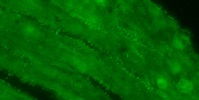Reproduction, Fertility and Development
Volume 33
Number 4 2021
Female fertility requires the timely influence of the ovarian steroid hormones oestradiol and progesterone, which are produced by the ovaries to prepare the uterus for attachment and implantation of the embryo. Osteopontin, also known as secreted phosphoprotein 1 (SPP1), is a glycoprotein present at the interface between the embryo and the uterus lumen. Analysis of uterine tissues collected from sheep in parallel with treatment of cultured endometrial cells with steroids showed progesterone as the main regulator of osteopontin expression, acting through the progesterone receptor and involving uterine epithelia and underlying stromal cells.
The major endocannabinoid N-arachidonoylethanolamine (AEA) is present in the follicular fluid (FF) of women with endometriosis. M1 macrophages induced AEA production by human granulosa cells, which may contribute to FF AEA concentrations. The elevated FF concentrations of AEA in patients with endometriosis may be associated with the recruitment of inflammatory chemokines within the ovary, which together may contribute to the decreased reproductive potential of women with endometriosis.
The uterine musculature must go through appropriate development and adaptations to stress during pregnancy to become a powerful contractile muscle capable of delivering an infant. This study discovered that the stress protein known as inducible heat shock protein A1A (HSPA1A) became highly expressed in rat uterine smooth muscle just before and during labour and was secreted from myometrial cells in vitro within extracellular vesicles. The results indicate that HSPA1A may have intracellular and extracellular roles that contribute to the regulation of birth.
Suboptimal nutrition and metabolic health can increase oxidative stress in oocytes and embryos, thereby affecting fertility. The strategic use of antioxidants protects oocytes against metabolic stress insults during embryo development. These findings highlight the importance of the timing of antioxidant treatment with the aim of protecting and safeguarding oocyte and embryo quality, and improving fertility.
In cattle farming, embryo mortality has increased in recent years. To understand this problem, IFNτ is of enormous importance. The present study investigated the effects of IFNτ, other Type I IFNs and progesterone on hepatocytes. The results demonstrate that IFNτ induces the expression of different genes, resulting in a systemic effect. Therefore, this study forms the basis for further investigations of early embryo mortality in cows.










